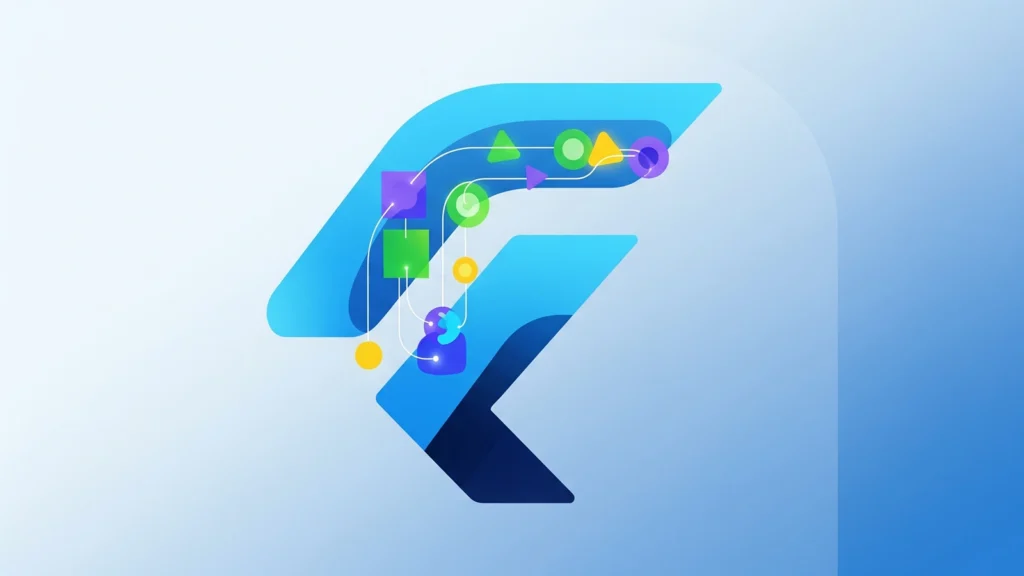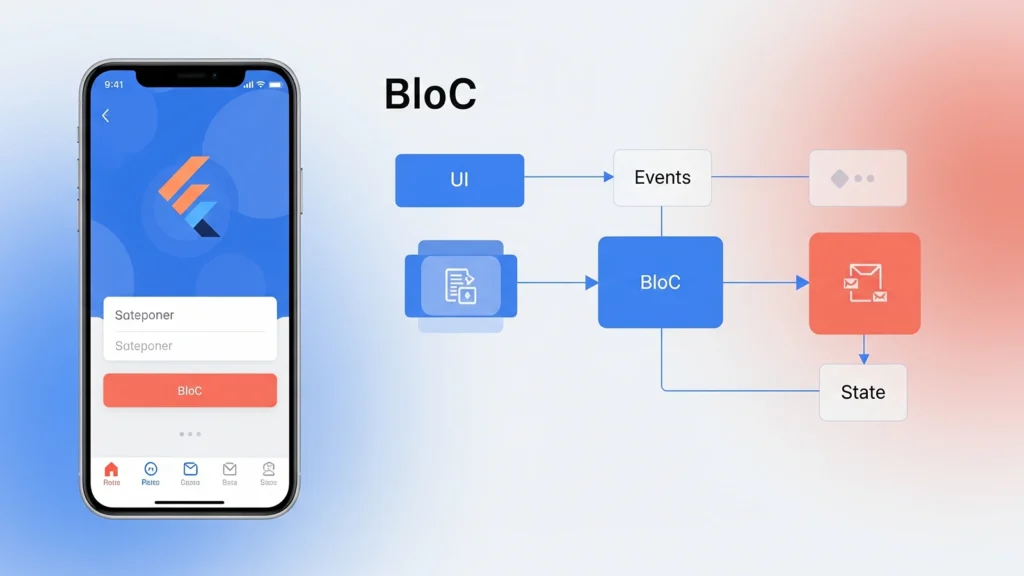
The BLoC (Business Logic Component) pattern, along with the official Flutter BloC (Flutter_bloc) library, is one of the most structured and robust state management solutions in the Flutter ecosystem. BLoC’s fundamental goal is to separate the application’s business logic from its UI/presentation layer, making the code highly scalable, testable, and reusable.
It operates on the principles of reactive programming, where the application flow is handled through a sequence of Events that trigger business logic, which in turn emits States to update the UI. This unidirectional data flow is key to BLoC’s predictability and stability.
1. Core Concepts and Architecture
The BLoC pattern enforces a strict boundary between the UI and the logic through three primary components.
1.1. The Unidirectional Data Flow
BLoC follows a clear, predictable pattern:
- The UI layer dispatches an Event (e.g., a button click).
- The BLoC (or Cubit) receives the Event.
- The BLoC/Cubit executes the Business Logic (e.g., an API call, data calculation).
- The BLoC/Cubit emits a new State (e.g., Loading, Success, Error).
- The UI layer listens to the State stream and rebuilds itself to reflect the new state.
1.2. Key Components
| Component | Role | Description |
| Event | Input/Action | Abstract classes or objects representing user actions or system events that trigger a change (e.g., LoginButtonPressed, DataFetched). |
| State | Output/Condition | Abstract classes or objects representing the current condition of the application/UI (e.g., LoginInitial, LoginLoading, LoginSuccess, LoginError). |
| BLoC (or Cubit) | Business Logic | The core class that takes an input stream of Events (or simple method calls for a Cubit) and transforms them into an output stream of States. |
2. BLoC vs. Cubit: The Main Difference
The flutter_bloc package provides two main classes for implementing the business logic: Bloc and Cubit.

| Feature | Bloc (Event-Driven) | Cubit (Method-Driven) |
| Input Mechanism | Events (Separate classes) | Methods/Functions |
| Handling Logic | Uses the on<Event>((event, emit) { … }) handler to map events to states. | Uses public methods that call the emit(newState) function directly. |
| Boilerplate | Higher, as it requires defining separate Event classes. | Lower, as it only requires defining the methods. |
| Complexity | Better suited for complex state transitions, event transformations (such as debouncing), and tracking the reason for a state change. | Better suited for simple state changes where you only care about the resulting state, rather than the initiating event. |
Rule of Thumb: Start with Cubit for simplicity. Refactor to a Bloc only if you need to intercept and transform the stream of events (e.g., debouncing a search query).
3. Flutter BLoC Widgets (The Consumers)
The flutter_bloc library provides powerful widgets to integrate your BLoC/Cubit with the Flutter widget tree.

| Widget | Purpose | When to Use |
| BlocProvider | Dependency Injection | To create and provide a single BLoC or Cubit instance to a widget subtree, making it accessible via context. read<T>(). |
| BlocBuilder | UI Rebuilding | To listen to a BLoC/Cubit’s state stream and rebuild a widget only when a new state is emitted and used for rendering UI elements. |
| BlocListener | Side Effects | To listen to a BLoC/Cubit’s state stream and perform side effects like navigation, showing a SnackBar, or displaying a Dialog. It does not rebuild the UI. |
| BlocConsumer | Combined | Combines the functionality of both BlocBuilder (for UI updates) and BlocListener (for side effects) into one widget. |
| RepositoryProvider | Dependency Injection | Used specifically to inject non-BLoC classes (e.g., API services, data repositories) into the widget tree, which BLoCs/Cubits can then access. |
4. Basic Implementation Example (Cubit)
A minimal implementation using Cubit for a simple counter:
- Define States:

| // counter_state.dartabstract class CounterState {}class CounterInitial extends CounterState {}class CounterUpdated extends CounterState { final int count; CounterUpdated(this.count);} |
- Create Cubit (Business Logic):
| // counter_cubit.dartclass CounterCubit extends Cubit<CounterState> { // Set the initial state CounterCubit() : super(CounterInitial()); // Method to handle the logic void increment() { final currentCount = (state is CounterUpdated)? (state as CounterUpdated). count : 0; // Emits a new state, triggering a UI rebuild emit(CounterUpdated(currentCount + 1)); }} |
- Provide and Consume in UI:
| // main.dart or a Screen widgetBlocProvider( create: (_) => CounterCubit(), child: Column( children: [ // BlocBuilder rebuilds when a new CounterUpdated state is emitted BlocBuilder<CounterCubit, CounterState>( builder: (context, state) { if (state is CounterUpdated) { return Text(‘Count: ${state.count}’); } return const Text(‘Count: 0’); // Initial state }, ), ElevatedButton( onPressed: () { // Access the Cubit and call the method context.read<CounterCubit>().increment(); }, child: const Text(‘Increment’), ), ], ),) |
Conclusion
Flutter BLoC offers a robust, opinionated, and highly scalable architectural approach to state management. Strictly separating Events (input), BLoC/Cubit (logic), and States (output) creates a predictable, deterministic, and easily testable application structure. While it requires more boilerplate than simpler solutions like Provider, the benefits in maintainability, scalability, and debugging for complex, feature-rich applications are substantial, making it a preferred choice for professional Flutter developers and large teams.

Frequently Asked Questions (FAQ)
When should I choose BLoC over Provider?
| Characteristic | Choose Provider | Choose BLoC/Cubit |
| App Size/Complexity | Small to Medium-sized apps. | Medium to Large-scale applications with complex state. |
| Logic Structure | Simple UI state and light logic (e.g., toggling a dark theme). | Complex business logic, forms, multi-step flows, and multi-API calls. |
| Predictability | Adequate. | Very high, due to the strict Event-State flow. |
| Testability | Good, but logic is often mixed with ChangeNotifier. | Excellent, as business logic is completely isolated and unit-testable. |
| Learning Curve | Gentle/Easy. | Steeper initially due to the Event/State concepts. |
What is the emit() function used for?
The emit() function is used inside a Cubit or a Bloc to send a new State object to the stream. Any widget listening to that BLoC/Cubit using a BlocBuilder or BlocListener will receive the latest state and react accordingly (rebuild the UI or perform a side effect).
How do I handle side effects (like navigation or showing a SnackBar) in BLoC?
Always use BlocListener or the listener property of BlocConsumer for side effects. Using a BlocListener ensures that the side effect (such as navigation) is executed exactly once per state change and does not run repeatedly within a widget’s build method, where BlocBuilder logic resides.
Why should I use separate classes for Events and States?
Using separate classes (often achieved with the Equatable package) offers two significant benefits:
- Readability/Clarity: It makes the application’s intent explicit and clear. The structure clearly shows what actions are possible and what conditions the UI can be in.
- Tracking/Debugging: It allows the BLoC library to provide excellent debugging tools by logging every single Transition (the change from one State to another triggered by an Event).
How can I access multiple BLoCs/Cubits in one screen?
Use the MultiBlocProvider widget.
| MultiBlocProvider( providers: [ BlocProvider(create: (_) => AuthBloc()), BlocProvider(create: (_) => ProductsCubit()), ], child: const HomeScreen(),) |
This prevents deeply nested BlocProvider widgets and keeps your application’s injection points clean and organized.
